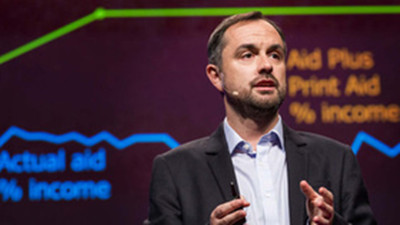I study the behavior of investors,how they react to policy and the economy.
我研究投资者的行为,研究他们如何应对政策和经济。
It gives me a different angle on the aid issue.
这在救助问题上给我新的启迪。
But it took an innocent question from my then-four-year-old daughter to make me appreciate that.
但是当时我年仅四岁的女儿问的一个童真的问题让我对此心有感激。
Pia and I were on the way to a local cafe and we passed a man collecting for charity.
当时皮娅和我正在去当地一家咖啡厅的路上我们经过了一个为慈善募捐的男人身边。

I didn't have any change to give him,and she was disappointed.
我当时没有给他零钱,她就有些失望了。
Once in the cafe, Pia takes out her coloring book and starts scribbling.
到了咖啡厅, 皮娅拿出她的图画本开始涂画。
After a little while, I ask her what she's doing,and she shows me a drawing of a 5 note to give to the man outside.
过了一会儿, 我问她在干什么,她给我看了她画的一张5欧元的钞票要给外面的那个男子。
It's so sweet,and more generous than Dad would have been.
非常温馨,远比她爸爸要慷慨得多。
But of course I explained to her,you can't do that; it's not allowed.
当然我跟她解释,你不能这么做,这行不通得。
To which I get the classic four-year-old response:
结果我得到的是四岁小孩经典的回答:
Why not?
为什么啊?
Now I'm excited, because I actually think I can answer this time.
现在我有点激动了, 因为我觉得我现在可以回答这个问题了。
So I launch into an explanation of how an unlimited supply of money chasing a limited number of goods sends prices to the moon.
所以我开始解释无限量供应的货币去购买限量供应的商品,是会把价格抬高到离谱的地步的。
Something about that exchange stuck with me,not because of the look of relief on Pia's face when I finally finished, but because it related to the sanctity of the money supply,a sanctity that had been challenged and questioned by the reaction of central banks to the financial crisis.
这次的交流让我久久不能忘怀,并不是因为在我快要结束的时候皮娅脸上露出安心的表情,而是因为它涉及到货币供应的神圣性,这种神圣性一直被中央银行对财政危机的反应所挑战和质疑。
To reassure investors,central banks began buying assets to try and encourage investors to do the same.
为了使投资方安心,中央银行开始购置资产尝试鼓励投资者也这么做。
They funded these purchases with money they created themselves.
他们用他们自己造出来的钱去投资这些购置。
The money wasn't actually physically printed.
而这些钱并没有真正被印刷出来。
It's still sort of locked away in the banking system today.
在今天这笔钱仍处于被锁在银行系统的状态。
But the amount created was unprecedented.
但造出来的这笔钱的数量却是空前的。
Together, the central banks of the U.S.,U.K and Japan increased the stock of money in their economies by 3.7 trillion dollars.
各国的中央银行,美国,英国和日本都一起增加了各自经济的货币存量增加了3.7万亿美金 (人民币约22.2万亿元)。
That's three times, in fact that's more than three times,the total physical stock of dollar notes in circulation.
这是三倍,其实不止三倍,实际流通中的美金货币存量总和。
Three times!
三倍啊!
Before the crisis,this would have been utterly unthinkable,yet it was accepted remarkably quickly.
在经济危机之前,这是完全不能想像的,但它还是非常快就被接受了。
The price of gold,an asset thought to protect against inflation,did jump,but investors bought other assets that offered little protection from inflation.
黄金的价格,黄金是被当作用来抵御通货膨胀的确实下跌了,但投资者购买了其他的资产,而这些资产却基本无法抵制通货膨胀。
They bought fixed income securities, bonds.
他们购买固定收益证券,债券。
They bought equities too.
他们也买普通股。
For all the scare stories,the actual actions of investors spoke of rapid acceptance and confidence.
对于那些吓人的报道,投资者真正的行为显示出快速的接受和信心。
That confidence was based on two pillars.
这种信心建立在两个支柱上。
The first was that, after years of keeping inflation under control,central banks were trusted to take the money-printing away if inflation became a threat.
第一个就是在控制通货膨胀的多年后,中央银行被人们所信任,如果通货膨胀构成威胁时他们可以停止钞票的印刷。



